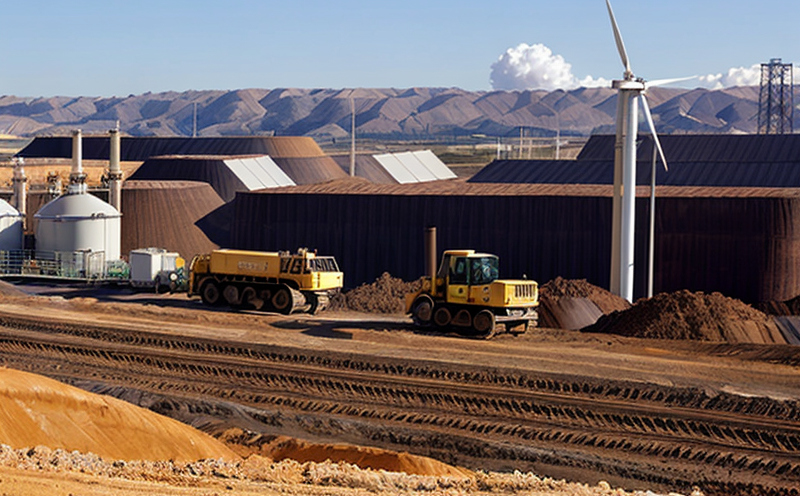ASTM D7582 Proximate Analysis of Fuel Efficiency in Mining Testing
The ASTM D7582 standard is a critical tool used to assess fuel efficiency in mining operations. This test measures the proximate analysis of coal and other solid fuels, providing insights into their energy content and potential for efficient combustion within mine environments. The primary goal of this test is to ensure that fuels are optimized for use in mining processes, thereby enhancing operational efficiency and reducing waste.
Understanding fuel efficiency in a mining context involves more than just the chemical composition; it also includes the physical properties like moisture content, ash, volatile matter, and fixed carbon. These parameters play a crucial role in determining how effectively a fuel can be utilized in boilers or other combustion systems within mines. By adhering to ASTM D7582, operators can ensure that they are selecting fuels that meet specific energy requirements without unnecessary additives or contaminants.
The test procedure outlined in ASTM D7582 is designed for laboratory use and involves several steps. First, a representative sample of the fuel is prepared by drying it at specified temperatures to remove moisture. Then, volatile matter is driven out under controlled conditions using a muffle furnace or similar apparatus. The remaining ash and fixed carbon are weighed separately after cooling.
This detailed analysis helps in identifying potential issues such as high ash content which can lead to increased wear on machinery during combustion processes. Additionally, low volatile matter might indicate incomplete combustion leading to higher emissions and wasted energy resources. Understanding these factors early allows for adjustments in fuel selection or processing methods to optimize performance and meet environmental regulations.
For quality managers responsible for ensuring product consistency across different mining sites, ASTM D7582 offers a standardized approach that ensures comparable results regardless of location or equipment used during testing. Compliance officers will find value in this test as it provides clear metrics against which compliance can be measured. R&D engineers may utilize these findings to develop new products aimed at improving fuel efficiency further.
In summary, ASTM D7582 is not just a laboratory procedure; it represents an essential part of maintaining efficient and sustainable mining operations. By providing precise data on fuel characteristics, this test supports decision-making processes that directly impact operational costs, environmental impacts, and overall safety standards within mines.
Why Choose This Test
Selecting the right testing method is crucial when aiming to improve efficiency in mining operations. ASTM D7582 offers several advantages over other testing methods due to its accuracy, reproducibility, and relevance to real-world applications.
- Standardization: Using ASTM standards ensures that all laboratories performing this test follow consistent procedures, leading to reliable and comparable results.
- Compliance: By aligning with industry best practices as defined by ASTM D7582, mines can ensure they meet regulatory requirements without compromising quality or safety.
- Efficiency: Understanding fuel characteristics allows for better management of resources, reducing waste and optimizing energy usage within mining processes.
- Sustainability: The insights gained from this test contribute to more sustainable practices by helping operators choose fuels that minimize environmental impact while maximizing productivity.
These benefits make ASTM D7582 an indispensable tool for those involved in managing fuel efficiency in mining. Whether you're looking to enhance operational performance, comply with standards, or pursue sustainability goals, this test offers unparalleled value.
Customer Impact and Satisfaction
The adoption of ASTM D7582 has significant implications for customers across various sectors within the mining industry. Quality managers benefit from having a standardized method to assess fuel efficiency, ensuring consistency in product quality across different sites. Compliance officers find comfort knowing that they are meeting regulatory requirements consistently.
R&D engineers can leverage the detailed information provided by this test to innovate and develop new products tailored specifically for improved fuel efficiency. Procurement teams gain confidence when selecting suppliers who adhere to such rigorous testing protocols, knowing it reflects high-quality standards in their supply chain.
End-users of mining equipment also see tangible benefits from ASTM D7582 implementation as they experience increased reliability and longevity due to optimized fuel performance. Safety is enhanced since suboptimal fuels are avoided, reducing risks associated with poor combustion or excessive wear on machinery.
In summary, choosing ASTM D7582 for proximate analysis of fuel efficiency in mining not only enhances operational efficiency but also fosters customer satisfaction through reliable and compliant practices throughout the supply chain.
International Acceptance and Recognition
- Australia: ASTM D7582 is recognized by Australian Standards (AS) as a reliable method for coal analysis.
- New Zealand: New Zealand’s national standard, NZS, references ASTM D7582 for coal quality assessment.
- European Union: The EU harmonizes with ASTM standards through its own directives, including those related to fuel efficiency and environmental impact assessments in mining sectors.
- United Kingdom: UK regulations often align closely with ASTM D7582 for coal quality assurance purposes.
The widespread adoption of ASTM D7582 across multiple regions underscores its importance as a globally accepted standard. Its recognition by major international bodies and national standards organizations ensures that the results obtained are widely applicable and respected worldwide.





